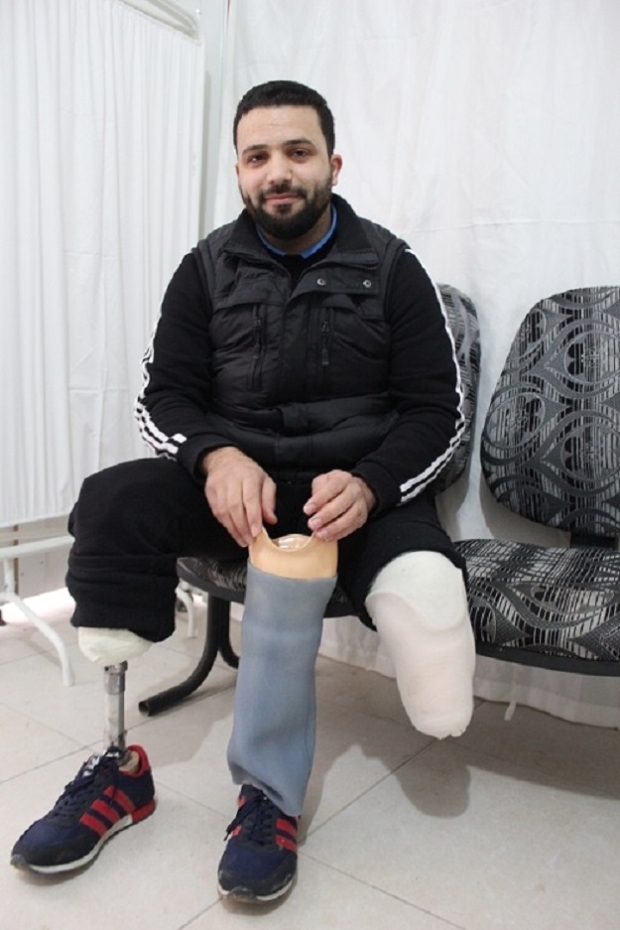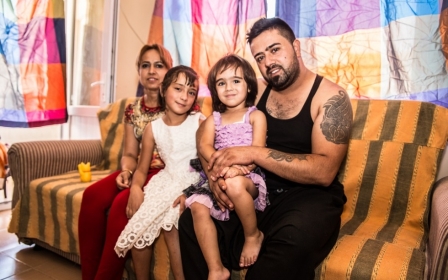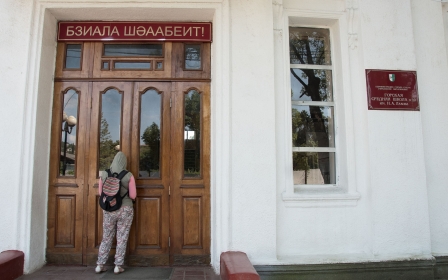Meet Husam, the scooter-riding Syrian amputee with an incredible story

REYHANLI, Turkey - In the Turkish border town of Reyhanli, Husam al-Zeno tends to his garden, where he grows potatoes, beans and tomatoes in his vegetable patch. “The tomatoes are the weakest,” he laughed.
“They die at the slightest cold,” he added.
On a sunny January day in the town, less than 10km from the Syrian border, he rides his Volta electric scooter from his home to a square, white building housing a prosthetic limbs clinic and workshop for refugees.
Before rolling up his tracksuit bottoms to reveal his prosthetic legs, it is hard to see that Zeno has been injured.
'I cook and wash dishes, clean the floor, clean the car, and other jobs'
"People who spend a lot of time with me know that I have an injury, but most people do not know,” he explained, sitting in the waiting room. “I work normally and nobody realises my injury. I cook and wash dishes, clean the floor, clean the car, and other jobs."
'My heart stopped twice because of the fear'
Zeno’s story started more than four years ago, when on 12 February 2013, he walked on his own two feet for the last time.
While visiting a friend in the Eastern Ghouta region of rural Damascus, shrapnel from a missile blast ripped through his body.
“I am not sure what kind of shell it was, but I think it was from a tank. I lost my feet straight away. I tried to stand up but I could not,” he said.
To this day Zeno still doesn't know who is responsible, but medics amputated both of his legs at the nearest hospital.
“A doctor told me that my heart stopped twice because of the fear,” the 30-year-old added.
For six months after his injury, Zeno crawled on the floor. “For a month, my friends helped me with everything: going to the toilet, the bathroom. Then I learnt to crawl on my knees. It was painful because all my weight was on them,” he said.
Yet he refused to feel hopeless. “I hated staying at home. I wouldn’t do that. I went out to my friends’ houses, to the supermarket, to the internet café.”
Zeno then obtained some ill-fitting, locally made prosthetics which he believes were made for a young female. They were his only choice if he wanted to walk more readily. "I think they were meant for a girl, not for a man," he explained. “They were made from iron. I walked using them for nine months. It was very painful because they were very soft, but I wanted to walk.”
The escape to Idlib
When his town of Kafra Batna came under siege from Syrian government forces in early 2013, he decided to escape the eastern Ghouta region.
The only way out was negotiating with the shabiha - state-sponsored thugs - with the objective of crossing through government territory to rebel-held Idlib province. The militia told him that if he made the journey without prostheses, he would have to pay a $2,000 premium, as he would slow them down. The ill-fitting legs would cause him pain if he wore them, but that would mean less hassle for the thugs and he'd only need to pay them $1,000. He chose the latter option and travelled to Idlib by car with the Shabiha.
'When any bombardment targeted us, my family were always running to save me'
After two months in the northern Syrian province, he obtained a more comfortable, better-fitting set of prostheses from a local clinic. But remaining inside Syria became tricky. Idlib was suffering steady air strikes from government warplanes, and Zeno could not move quickly to escape shelling.
“When any bombardment targeted us, my family were always running to save me. They would forget everything trying to save me and I do not want to be in the same situation again,” he said. In the end Zeno managed to cross from Idlib to Turkey as a Syrian in need of medical treatment.
The plight of Syria's amputees
Last week, the world's attention was drawn to the plight of Syria's amputees, when footage of a boy whose legs had been blown off in a presumed barrel bomb attack was shared widely online. The 10-year-old victim, Abdel Basset, was filmed crying, "Dad, pick me up! Pick me up!" as he flailed desperately on the ground. The boy survived and is now receiving treatment in Turkey.
Zeno and Basset are among more than an estimated 30,000 Syrians who have lost limbs in the conflict that has raged for nearly six years, according to statistics. These figures are conservative and have almost certainly increased.
According to aid workers, it is hard to accurately tally the number of amputees because many people remain confined to their homes after their injuries.
The widespread shelling of built-up civilian areas in Syria has left all age groups and both sexes vulnerable to wounds requiring amputation. Buildings collapsing from mortar shells and air strikes, gunfire and cluster bombs mean civilians are commonly left with messy, painful injuries.
A lack of access to antiseptics and fully-functioning hospitals has also increased the number of amputations since medics are not able to save victims' injured limbs.
According to the organisation Physicians for Human Rights, which documents attacks on healthcare in Syria, there were 400 attacks on 276 separate facilities between March 2011 and July 2016.
A group effort
Life is not easy for Zeno who suffers nerve pain every day, and walking still requires enormous effort.
“There is pain, of course – neurological pains, and from the sensitivity of my skin from friction with the prostheses. And the fatigue – it takes great effort to walk, and that is really tiring,” he said.
He showed MEE the elaborate set of bandages and tight socks he uses to tie his leg stumps to the prosthetics, which he adapted to quickly.
"These ones [the prosthetics] were better than the last ones,” he chuckled.
Not having seen his parents or sister for two years, one day he would like to return to Syria. But for now he feels his life is fuller in Turkey, where he manages an aid distribution centre in Reyhanli.
“I can be more useful in Turkey than in Syria. There are a lot of Syrians here now. They have streets and schools and areas. Integration is coming along: we can do so without leaving our Syrian traditions. We can integrate through language, education, and trading, because we need to live.”
The clinic opened in March 2013, and since then the all-Syrian team of 45 technicians and doctors have made and fitted 4,000 prostheses on 3,000 patients.
'I do not feel sad about my injury. It doesn’t matter if we lost legs, fathers, mothers, or children. It is about a free Syria'
Manager Raed al-Masri said that nearly all of the injuries seen in the clinic are war-related, with more than 80 percent caused by mines, or aerial bombardments and mortar shells on civilian areas such as markets, homes and schools. Some 20 percent of patients are children.
“The reasons are always different: bombardment, mines, or other reasons," he explained in his office on the Reyhanli clinic’s upper floor. "But most of them are because of the war," he said.
Most of the work is on lower-limb prosthetics, but they also make splints for burn victims, and props for patients with back paralysis. One model in the workshop shows a full-torso cast. From the size, the female patient would be no older than 10.
Since the Turkish border was effectively closed to all but the most severely injured Syrians in early 2015, the NSPPL team has seen a decline in the number of patients at the Reyhanli facility. But numbers of people seeking help have risen at its two branches in Syria’s Idlib province. So far, neither has been bombed, although they have had to close temporarily when air strikes have hit nearby.
Major challenge
Obtaining prosthetics is a major challenge for Syria’s displaced populations: in surrounding countries, up to 90 percent of refugees live below the poverty line, according to UN figures.
A basic prosthetic leg costs around $500; more expensive models, such as electric hands, may cost up to $2,000. Many amputees, mostly unable to work due to their injuries, cannot afford these costs.
Even when Syrians obtain free limbs and support through NGOs such as NSPPL, demand outweighs supply. The organisation currently has an eight-month waiting list.
“These amputees will not get their limbs back. They will need us to the end of their lives,” Masri said. “They need to replace the parts every year, and even if the war ended, they will still come. So maybe we will care for them for 20, 30, or 40 years, nobody knows.”
Amputees risk stigma and rejection from their families and communities, who may believe that they are “broken” and are no longer functioning human beings. But Zeno manages to maintain a positive outlook.
“I do not feel sad about my injury. It doesn’t matter if we lost legs, fathers, mothers, or children. It is about a free Syria. This is what we do not want to lose.”
Later, he sends a WhatsApp message on the state of his garden.
"It is too early to pick the fruit yet. The ground is still at the cultivation stage. There is time in the future."
New MEE newsletter: Jerusalem Dispatch
Sign up to get the latest insights and analysis on Israel-Palestine, alongside Turkey Unpacked and other MEE newsletters
Middle East Eye delivers independent and unrivalled coverage and analysis of the Middle East, North Africa and beyond. To learn more about republishing this content and the associated fees, please fill out this form. More about MEE can be found here.






